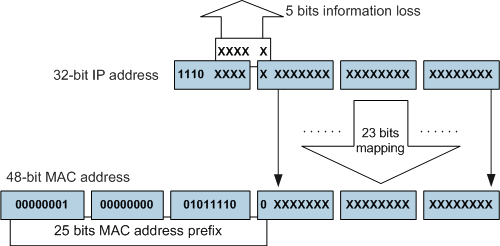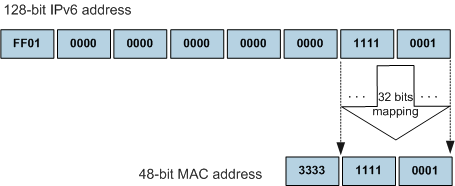Multicast Addresses
To enable multicast sources and group members to communicate, the network must provide network-layer multicast services using multicast IP addresses. Additionally, to enable multicast data to be correctly transmitted on the local physical network, the network must provide link-layer multicast services using multicast MAC addresses. The destination address of a multicast data packet is a group with unknown members but not a specific receiver. Therefore, multicast IP addresses must be mapped to multicast MAC addresses.
IPv4 Multicast Addresses
The Internet Assigned Numbers Authority (IANA) allocates Class D addresses for IPv4 multicast. An IPv4 address is 32 bits long, and the first four bits of a Class D IP address are 1110. Therefore, multicast IP addresses range from 224.0.0.0 to 239.255.255.255. Table 1 describes IPv4 multicast addresses.
Class D Address Range |
Description |
|---|---|
224.0.0.0-224.0.0.255 |
Permanent multicast group addresses that are reserved by the IANA for routing protocols. The addresses identify a group of network devices and are not used for multicast forwarding. Table 2 lists the permanent multicast group addresses. |
224.0.1.0-231.255.255.255 233.0.0.0-238.255.255.255 |
ASM group addresses that are valid on the entire network. |
232.0.0.0-232.255.255.255 |
Default SSM group addresses that are valid on the entire network. |
239.0.0.0-239.255.255.255 |
Administrative multicast addresses that are valid only in the local administrative domain. Different administrative domains can use the same administrative multicast addresses. |
Permanent Multicast Group Addresses |
Description |
|---|---|
224.0.0.0 |
Unassigned |
224.0.0.1 |
All the hosts and routers on a network segment (similar to a broadcast address) |
224.0.0.2 |
All multicast routers |
224.0.0.3 |
Unassigned |
224.0.0.4 |
Distance Vector Multicast Routing Protocol (DVMRP) routers |
224.0.0.5 |
Open Shortest Path First (OSPF) routers |
224.0.0.6 |
OSPF designated routers (DRs) |
224.0.0.7 |
Shared tree (ST) routers |
224.0.0.8 |
ST hosts |
224.0.0.9 |
Routing Information Protocol version 2 (RIP-2) routers |
224.0.0.11 |
Mobile agents |
224.0.0.12 |
Dynamic Host Configuration Protocol (DHCP) servers or proxy agents |
224.0.0.13 |
All Protocol Independent Multicast (PIM) routers |
224.0.0.14 |
Resource Reservation Protocol (RSVP) encapsulation |
224.0.0.15 |
Core-based tree (CBT) routers |
224.0.0.16 |
Specified Subnetwork Bandwidth Management (SBM) device |
224.0.0.17 |
All SBM devices |
224.0.0.18 |
Virtual Router Redundancy Protocol (VRRP) |
224.0.0.22 |
IGMPv3 routers |
224.0.0.19-224.0.0.21 224.0.0.23-224.0.0.255 |
Unassigned |
IPv6 Multicast Addresses
An IPv6 address is 128 bits long. The IPv6 multicast address format is shown in Figure 1.
An IPv6 multicast address has a Group ID field to identify a multicast group.
FF: The leftmost eight bits are 11111111, indicating a multicast address. All IPv6 multicast addresses start with FF.
- Flags: This field is 4 bits long and identifies the state of a multicast address.
Table 3 Description of flag values Value
Description
0
Permanent multicast group addresses that are reserved by the IANA
1
ASM group addresses
2
ASM group addresses
3
SSM group addresses
Others
Unassigned
- Scope: This field is 4 bits long and identifies the scope of a multicast group, for example, whether a multicast group covers nodes in the same network, same site, same organization or any node in the global address space.
Table 4 Description of Scope field values Value
Description
0, 3, F
Reserved
1
Node/Interface-local scope
2
Link-local scope
4
Admin-Local scope
5
Site-local scope
8
Organization-local scope
E
Global scope
Others
Unassigned
- Group ID: This field is 112 bits long and identifies a unique multicast group in the range specified by the Scope field. The Group ID can be permanently or temporarily assigned, depending on the value of the T flag in the Flags field.
Table 5 describes the IPv6 multicast address ranges.
Range |
Description |
|---|---|
FF0x::/32 |
Reserved group addresses (see Table 6). |
FF1x::/32 (x is not 1 or 2) FF2x::/32 (x is not 1 or 2) |
ASM group addresses that are valid on the entire network. |
FF3x::/32 (x is not 1 or 2) |
Default SSM group address range. Addresses in this range are valid on the entire network. |
Range |
IPv6 Multicast Addresses |
Description |
|---|---|---|
Node/Interface-local scope |
FF01::1 |
All node or interface addresses |
FF01::2 |
All router addresses |
|
Link-local scope |
FF02::1 |
All node addresses |
FF02::2 |
All router addresses |
|
FF02::3 |
Unassigned addresses |
|
FF02::4 |
DVMRP routers |
|
FF02::5 |
OSPF IGP routers |
|
FF02::6 |
OSPF IGP DRs |
|
FF02::7 |
ST routers |
|
FF02::8 |
ST hosts |
|
FF02::9 |
RIP routers |
|
FF02::A |
EIGRP routers |
|
FF02::B |
Mobile agents |
|
FF02::D |
All PIM routers |
|
FF02::E |
RSVP encapsulation |
|
FF02::1:1 |
Link name |
|
FF02::1:2 |
All DHCP proxy agents |
|
FF02::1:FFXX:XXXX |
Solicited-node addresses (XX:XXXX indicates the last 24 bits of a node IPv6 address) |
|
Site-local scope |
FF05::2 |
All router addresses |
FF05::1:3 |
All DHCP servers |
|
FF05::1:4 |
All DHCP relay agents |
|
FF05::1:1000-FF05::1:13FF |
Service location |
IPv4 Multicast MAC Addresses
When unicast IPv4 packets are transmitted on an Ethernet network, the packets use MAC addresses of receivers as destination MAC addresses. However, the destination of a multicast data packet is a group with changeable members but not a specific receiver. Therefore, multicast data packets must use IPv4 multicast MAC addresses on an Ethernet network. IPv4 multicast MAC addresses are link-layer addresses mapped from IPv4 multicast addresses.
As defined by the IANA, the leftmost 24 bits of an IPv4 multicast MAC address are 0x01005e, the 25th bit is 0, and the rightmost 23 bits are the same as the rightmost 23 bits of a multicast IPv4 address, as shown in Figure 2. Multicast MAC address 01-00-5e-00-01-01 is mapped to multicast IP address 224.0.1.1.
The first four bits of an IPv4 multicast address are fixed as 1110, mapping the leftmost 25 bits of a multicast MAC address. Among the last 28 bits, only 23 bits are mapped to a MAC address, and 5 bits are lost. As a result, 32 multicast IP addresses are mapped to one MAC address. For example, multicast IP addresses 224.0.1.1, 224.128.1.1, 225.0.1.1, and 239.128.1.1 are all mapped to multicast MAC address 01-00-5e-00-01-01. Address conflicts must be considered in address assignment.
IPv6 Multicast MAC Addresses
In an IPv6 multicast MAC address, the leftmost 16 bits are 0x3333, and the rightmost 32 bits are mapped to the rightmost 32 bits of an IPv6 multicast address. Figure 3 shows the mapping between IPv6 multicast address FF01::1111:1 and an IPv6 multicast MAC address.
The figure shows that more IPv6 multicast addresses are mapped to the same multicast MAC address.


